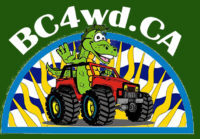There are very few types of terrain more demanding on vehicles and drivers than rock. A vehicle that lacks the necessary skid plates and body protection can get torn apart, and even skilled drivers will get hung up on occasion.
Rock can also cut the sidewalls of your tires. Tires are rated "P" for passenger cars or "LT" for light truck tires. Light truck tires typically have much stronger sidewalls than passenger car tires, and All Terrain or Mud Terrain tires usually have the best sidewall strength. Don't go into rock with "P" rated tires or they are unlikely to survive. Also if you have significantly increased your tire size without changing your gearing to match you will not be able to go slow enough to stay in control on difficult rocky sections.
Never venture onto rocks without a spare tire, a second vehicle, and recovery equipment, and use a "Spotter" to guide you through the tough parts.
The first rule of "Rock Crawling" is to place your tires on the larger rocks rather than let them go under your axles. This raises you up farther from the other rocks and keeps the rocks away from the lowest and most vulnerable points on your vehicle. Of course dropping off the rock onto the body of your rig is less than desireable, so you either need to be very aware of the clearance you have, or have "Rock Rails" - body armor that protects from wheel to wheel under your doors.
There's a reason why it's called Rock Crawling and you need to pay attention to it and Crawl. Bashing into rocks will bend or break suspension and steering components, increase the damage done by impacts, and adds to the chance of cutting a tire on sharp edges. You should be in 4wd LOW and first gear, only moving fast enough to keep your engine from stalling. If you do stall and are in a tough spot try starting your vehicle with the clutch out (not all vehicles will allow this). That way you don't have to ride the clutch to get moving.
Every type of rock has it's own challenges. "Rocky Road" near Vernon BC is three kilometers of loose volcanic rock that crumbles under your tires. The texture of the rock means that just seeing all the dips and crags to pick a line can be challenging, and the sharp rock loves to tear open tires. If you choose the optional climb and descent at the 1/3 mark you quickly find that hitting your brakes is almost pointless as the rock just rolls under your tires and carries you along.
Granite boulders are the most common rocks you will encounter in BC. They tend to rotate when you bump them, high centering you in a spot you thought you had clearance for.
[embedyt] https://www.youtube.com/watch?v=kLSI990hi9Y[/embedyt]
Granite slabs can be tricky to climb due to lack of traction and vertical steps. In this video Teo shows that a near stock rig can make it up a difficult section through a combination of good line choice and excellent throttle control.
[embedyt] https://www.youtube.com/watch?v=tQ8_hjACnro[/embedyt]










